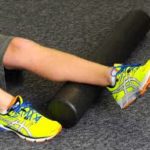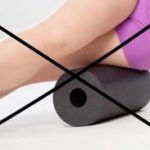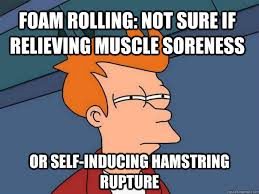Foam rolling has become one of the most popular exercise tools in the sports and rehab world. At some point, most of us have found ourselves rolling up and down this piece of styrofoam hoping for pain relief or improved muscle flexibility. We may have even had short-term relief. But, let’s be honest. Most of us have a hate-hate relationship with the roller. Why? Because rolling on it hurts so dang much! It really makes you think: Is this tool worth the time and pain? Am I really getting any benefit from this? What is foam rolling actually doing?
Foam rolling is touted to increase joint range of motion, decrease muscle soreness and improve performance. No wonder so many of us jump on this piece of foam and roll away. But, here’s the real question: does it actually help?
A LITTLE HISTORY
Foam rolling (FR) was originally developed as a form of self-massage or self-myofascial release. In 1987, a physical therapist named Sean Gallagher invented foam rolling while studying the Feldenkrais method. The Feldenkrais Method® is a form of somatic (body) education that uses gentle movement and directed attention to improve movement and enhance human functioning.
This is not a post about the Feldenkrais method, but it is important to note that foam rolling was originally a mindful and precise form of myofascial release. If these principles are used, FR can be an effective adjunct to physical exercise and movement. Notice the word adjunct. Foam rolling is not the quick, universal answer to every pain or niggle in the body…yet most people think it is.
THE GOOD
Although research is inconclusive on the effects of FR, there are some positive themes emerging.
- Foam rolling may have positive SHORT-TERM effects on joint range of motion without affecting performance. Well, that’s awesome! It is important to note that static stretching does have a negative effect on muscle performance. So, to have a tool that may help increase range of motion for the short term could be super cool. Ok, how long should you roll? Short bouts. Only 30- 60 seconds per area. Yes, that’s it! I say “may” have positive effects because the research is too weak to draw a solid conclusion. But, the thought is that FR affects the viscoelastic properties (or gel-like behavior) of the fascia, allowing the body to move through space that much easier.
- Foam rolling may improve recovery and decrease perceived soreness or DOMS (delayed onset muscle soreness) after high intensity exercise. DOMS is now being understood as a change in the connective tissue or fascia properties of the muscle, rather than just the muscle. Research suggests that FR would increase blood flow and allow for greater oxygen delivery to help heal the “sore” connective tissue. Post exercise, the recommendation is 10-20 minutes, especially on the legs. Note: this is only after a high intensity workout.
- The foam roller affects the connective tissue, not the muscle. This is helpful to know. Most of us think the foam roller will increase our long-term flexibility and muscle length. Instead, FR may help create more “gel-like” fascia to allow for a deeper muscle stretch.
In summary, foam rolling may have great short-term benefits! Long term? We just don’t know…
THE BAD
Foam rolling is replacing the dynamic warm-up and post-workout stretching. Gah! As stated above, it may be a great adjunct for short-term gains, but it should not be replacing anything.
The Dynamic Warm-Up
Without a thoughtful dynamic warm-up, your muscles are more vulnerable to injury. This short pre-workout routine is designed to warm up specific muscle tissue and neurologically connect your brain and body for coordinated movement. It is a warm-up from the INSIDE-OUT. Not the outside-in (like the foam roller).
 IMAGINE YOU’RE ABOUT TO GO ON A RUN…
IMAGINE YOU’RE ABOUT TO GO ON A RUN…
The main muscles in running are the glutes, deep abdominals and calf muscles. An effective dynamic warm-up could include clams, fire hydrants, [1] calf raises, and a plank that brings the opposite knee to elbow. Performing 10-15 reps of each would be sufficient and take about 3-4 minutes. Do you see that this is very different than just rolling around on the foam roller for 3-4 minutes? I sure hope so.
Post-Workout Stretching
After exercise, each of us should be taking time to stretch. I know, I know. Who likes to stretch? But, it is imperative for our muscle tissue to be stretched and lengthened after a workout, especially when it’s still warm.
YOU’RE NOW COMPLETING THE RUN… (wouldn’t it be great if running was that quick and easy?!)
Most of us instantly stretch our quads (thigh muscles) but the calf and glute muscles should also be added to the mix. Holding each stretch for 30-60 seconds is usually plenty. You’re looking at another 3-4 minutes of work…you can do it! Here is a link to a blog post I wrote about the importance of stretching: STRETCHING. [2]
A note about tight quadriceps and calf muscles
 These are two common areas that people love to foam roll. These are big muscle groups and can “fight” against the foam roller. Trying to release them on the roller simply doesn’t work. It actually makes them a little mad. If you have tight quadriceps or calf muscles, please stop the rolling madness and STRETCH!
These are two common areas that people love to foam roll. These are big muscle groups and can “fight” against the foam roller. Trying to release them on the roller simply doesn’t work. It actually makes them a little mad. If you have tight quadriceps or calf muscles, please stop the rolling madness and STRETCH!
THE UGLY
Foam Rolling ≠ Rehab
The foam roller does not heal an injury. Let me repeat that. The foam roller does NOT heal an injury. But, who hasn’t been told to plop on this piece of styrofoam and roll away if they complain about dysfunctional pain? There is one common injury where foam rolling seems to be the Very. Best. Answer. Ever. Did you guess it?

IT Band Syndrome. Yes, the IT Band is irritated. But, why? Are your glutes not firing well? Does your tibia not internally rotate? There are so many factors into the WHY of dysfunction. A piece of styrofoam will not fix the real issue. Seriously, you’re wasting your time. Pain is a signal from the body that something is not going right. Listen to that, get off the roller and call a physical therapist!
If you’d like to read more on IT Band Syndrome, here is a link to blog post I wrote: IT BAND SYNDROME. [3]
Foam Rolling is Too Aggressive
 Remember, FR was developed from a very mindful and gentle theory. It’s purpose is to affect the fascial elements of tissue and allow for more pliability or flexibility. However, when I see most people on the foam roller, it makes me cringe. SO AGGRESSIVE! They are rolling over bony areas (hello bursitis!), the sciatic nerve (please stop!) and apply WAY too much pressure to be effective. And, here’s the worst part. If you are dealing with pain (dysfunctional pain, not workout pain), do you really think you should be aggressively rolling around on the roller?
Remember, FR was developed from a very mindful and gentle theory. It’s purpose is to affect the fascial elements of tissue and allow for more pliability or flexibility. However, when I see most people on the foam roller, it makes me cringe. SO AGGRESSIVE! They are rolling over bony areas (hello bursitis!), the sciatic nerve (please stop!) and apply WAY too much pressure to be effective. And, here’s the worst part. If you are dealing with pain (dysfunctional pain, not workout pain), do you really think you should be aggressively rolling around on the roller?
I know the world has adopted a love for this inventive tool. And, as stated above, it may have some short-term benefits. But, please don’t forget to do a dynamic warm-up before your exercise of choice and finish with some stretching. If you want to add the foam roller as an adjunct…go for it! Just make sure you are free of injury before you do so.
Take Home Points
- Foam rolling affects the connective tissue or fascia of the musculoskeletal system, not the muscle tissue
- Pre-workout, short bouts of rolling may have positive short-term effects for increasing joint range of motion
- Post-workout (high intensity only), 10-20 minutes of rolling may help decrease DOMS
- Perform a dynamic warm-up before exercise and static stretching after exercise
- The foam roller does not heal injury in the body
Thank you for reading! If you enjoyed this post and found it helpful, please share so others can learn too.
© 2016 & Beyond. ALL BLOG CONTENT at duncansportspt.com by Lori Duncan PT
 ABOUT THE AUTHOR
ABOUT THE AUTHOR
Lori Duncan, DPT, MTC, CPT is a respected physical therapist and Pilates instructor in Lafayette, CO and the owner of Duncan Sports Therapy + Wellness. She is passionate about preventive physical therapy and education. She can be reached at [email protected].
References
Cheatham SW, Kolber MJ, Cain M, Lee M. The effects of self-myofascial release using a foam roll or roller massager on joint range of motion, muscle recovery and performance: a systematic review. Int J Sports Phys Ther. 2015:10(6);827-838.
![]()